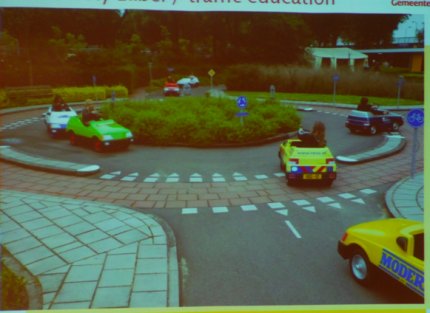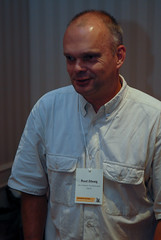
(Photo © J. Maus)
There’s a strong myth going around that the people from Western Europe’s most bike friendly cities are somehow just different. They must be born with a gene that makes them bike as a natural extension of life, right? Well, the more you learn about cities like Amsterdam, Copenhagen, and Utrecht, the more you realize that’s simply not true.
In all of those cities, planners and city engineers have worked hard to create a culture where streets are much more humane and where people voluntarily make the choice to ride, not because it’s some sort of statement or part of their identity, but because it is their preferred option.
At the Safe Routes to School National Conference yesterday, we learned that one way bikes have become so ingrained into those cultures is because they take youth education very seriously (unlike here in the U.S. where it took until 2005 before the federal government funded Safe Routes to School programs).
In Utrecht (with a bike usage share of 33% and up to 50% in the central city), school kids have access to a “traffic garden”. In a nutshell, it’s a mini-streetscape where elementary level kids operate pedal-powered vehicles. The goal is to learn how to be a responsible road user.
According to Utrecht’s bike program coordinator Ruud Ditewig, the facility is owned by the City of Utrecht and it has been in operation since the 1950s. School kids in that city take regular field trips to the traffic garden. Once there, they all assume various road user roles and the different modes are assigned different levels of responsibility.
Ditewig noted that all the kids want to drive the ambulance, which is also the vehicle with the top priority in the system (below that is a police car, a bus, a car, a bike, and so on).
A police officer or school official stands watch over the kids with a megaphone. If someone makes a poor decision or acts irresponsibly, they are called out and demoted, having to then work their way back into the game. “None of the kids want to be the pedestrian” noted Ditewig.
The learning happens when the kids realize that they must earn their right to operate a motor vehicle and that, if they make a bad choice, they will have that privilege taken away immediately (and in front of their social peers).
Greg Raisman, a traffic safety specialist with the City of Portland Bureau of Transportation observed Utrecht’s traffic garden during a visit last month. He said he was impressed by the focus on lifelong education. “It’s a great way to build an ethic of responsibility”.
There are many other traffic gardens throughout Europe, but so far none in the U.S. That might change though, according to Vivian “Kit” Keller with the Association of Pedestrian and Bicycle Professionals. Keller was part of an “International Scan Team” of 12 transportation professionals that took a trip through Europe in June. The goal of the trip to was observe innovations in biking and walking safety and mobility.
Keller said that group — which included officials from major federal agencies like NHTSA and the FHWA — was very impressed when they observed a traffic garden in action in Winterthur, Switzerland. In fact, they appreciated its potential so much that Keller said they will make traffic gardens part of their official policy recommendations.
National Safe Routes advocates are pushing to triple funding for the program in the new transportation bill. If that happens, traffic gardens could become an important educational tool and America will be on the way to more humane streets in the future.


